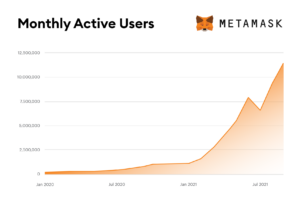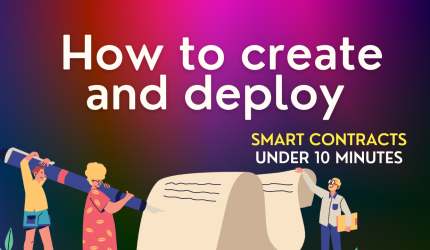I want you guys to think of the first ever Nokia 3310 phone or the Blackberry phone that you bought. Or the first big fat PC you bought connected to a dial-up connection for the internet.
Did this bring in some fond memories?
Mobile phones have become smarter and the specifications of them have dramatically improved. In fact Apple was at the forefront of the smartphone revolution with its iPhone release in 2007.
To give you a magnitude of smartphone adoption, there are close to 6.65 billion smartphone users.

Keeping the world population at 8 billion, more than 80% of the world’s population uses a smartphone. The data may be a bit skewed due to demographics but you get the point right?
A small comparison
I want you to now see the below chart of Metamask users. Before moving ahead, for those of you who don’t know, Metamask is a wallet you use for everything related to web3.
Simply put, it’s one of the keys to unlock access to a lot of possibilities in web3 like decentralized apps, NFTs, decentralized finance and so on.
Metamask has a MAU (monthly active users) of 10million. The growth rate is crazy but still it is a paltry 0.125% of the world’s population.
There are other tools like Metamask too that help you create a wallet but I picked the most popular and most adopted one.

I hope you got a sense of how early we are to make Web3 mainstream just like other revolutions in the past.
The idea of web3.0
But before we move forward, let’s first explore the idea of web3 first.
Simply put, web3 is an idea to create a better and more secure internet and give ownership of assets to people who use the internet.
There are few major issues that current internet companies face.
- Security
- Data Privacy
- Ownership
- Trust
- Centralisation
Web3.0 is a bridge to provide ownership to users of all the digital assets and more control over their data.
Bringing the idea of web3.0 to reality through dApps
In web2.0, our primary form of interaction on the internet is through websites or applications.
High chances are that you are reading this on a web browser which is also a kind of a website.
However, in web2 our data is stored with a central body with no ownership or control of it.
Hence, it makes sense to create websites and applications that can help us store our data in a decentralized and secure way. And obviously let us own assets.
What kind of assets?
Ever played Fortnight? Imagine all the Fortnight skins and in-game characters. What if you own these in-game characters and can trade them with other players?
Yes, that’s exactly what play-to-earn games do. Using NFTs (non fungible tokens), you can own these digital assets and these assets are rare and unique.
Moving on…
With this idea in mind a lot of dApps (decentralized apps) started to build on top of blockchain.
Why blockchain?
This is because blockchain tech allows you to store data in a transparent and decentralized way.
Blockchain is a basically immutable ledger. In simple words, you can call it a shared database.
Now, if dApps are built on top of blockchain how does the distribution of assets like NFTs, tokens happen?
If the distribution is manual, you may be wondering again this gives the power to a human to manipulate the data.
That’s why smart contracts are necessary in dApps to ensure the auto execution of such things without any human element.
But what are smart contracts?
In simple words, they are programs stored on blockchain that run when some conditions are met.
For example, if you win a contest, then you get rewarded with one NFT in your wallet.
Now you understand that smart contracts are absolutely essential so that all intermediaries are removed and you can be sure that a certain thing will happen if certain conditions are met.
Reaching the smart contract design spiral:

The need for a smart contract design tool
As you can see from the spiral, designing a smart contract in 2022 is architecturally very hard.
Because of the various blockchain, different protocols and changing versions of Solidity, it becomes extremely hard to design an optimum smart contract.
On top of that it is very time consuming and effort intensive.
Hard + Time consuming = Low adoption = High Barrier to Entry
So, what do we do about this?
To make innovators’ lives easier we are creating a platform that helps them create smart contracts using a few clicks of a button.
Our aim to automate the development lifecycle of web3.0 dApps
What are we building?
We are creating pre-build smart contract templates for most popular web3.0 use-cases. You can even customize the templates as per your needs with a few clicks.
Staking, NFT marketplace, Swap, NFT collection- we covered it all.
Using Accelchain we want to empower innovators, developers and early adopters eventually leading to mass adoption.
The goal is to reduce the barrier to entry and make the process easier and faster.
Easy ⏩ Fast ⏩ Secure ⏩Efficient⏩
We want you all to create smart contracts on the go
Reduced barrier to entry to create smart contracts will help in creation of more dApps and exciting use-cases.
As the dApps increase, then more people will be on-boarded onto the ecosystem.
If you have any idea in the web3.0 space like a deFi application or a play-to-earn game or an NFT based idea like a marketplace, your starting point is having a smart contract and your magic wand to enable that is Accelchain.
Want to experience the power of the platform? Join our waiting list to jump the queue.



